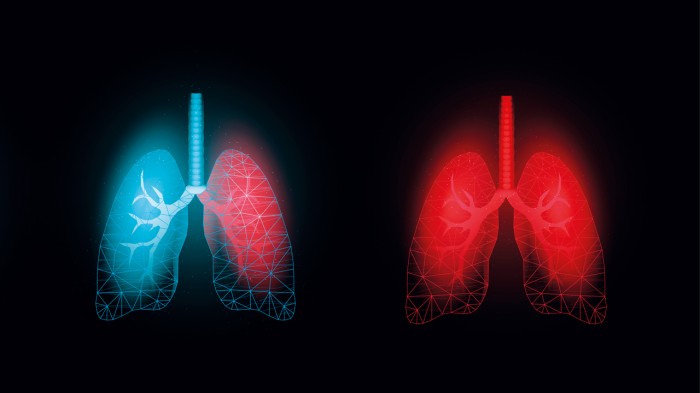In Clinical
Let’s get clinical. Follow the links below to find out more about the latest clinical insight in community pharmacy.Bookmark
Learning objectives
After reading this clinical review article you should be able to:
- Recognise the signs that a patient’s asthma is not well controlled
- Undertake an asthma review
- Support patients who need to step up their treatment.
Key facts
- At least one in five asthma patients in the UK may have uncontrolled disease, which can lead to life-threatening attacks
- A patient’s inhaler technique and asthma plan should be reviewed regularly to optimise care and prevent attacks
- Always refer a patient with uncontrolled asthma to a specialist if they have frequent attacks or present with any red flags
A survey by the Taskforce for Lung Health found three-quarters of people with lung disease who use community pharmacies value their services because they are close to home. However, many patients aren’t having their inhaler technique checked in pharmacies — a missed opportunity.
“Inhaler technique checks are currently only done on an ad hoc basis or when someone is prescribed a new type of inhaler because community pharmacies aren’t funded to provide annual checks – this is despite the fact that for other disease areas, like CVD, community services have been enhanced,” says Dr Andrew Whittamore, clinical lead at Asthma + Lung UK.
“Asthma is a misunderstood condition and there can be complacency about its symptoms and treatments, including how to use inhalers correctly. Poor inhaler technique can lead to potentially life-threatening asthma attacks, so it is really important that people with asthma receive annual inhaler technique checks from their GP or community pharmacist, to help them to understand their condition and get a handle on [managing] their symptoms,” he says.
In a 2020 survey carried out by Asthma + Lung UK, 24 per cent of survey respondents said they had uncontrolled asthma. Proportionally, this means that 1.3 million people in the UK are at risk of a life-threatening asthma attack.
A patient with uncontrolled asthma will present with:
- Coughing
- Wheezing
- Chest tightness
- Shortness of breath.
According to NICE, they will experience these symptoms either:
- Three or more days per week, with or without the use of a SABA for symptomatic relief
- One or more nights a week where their symptoms wake them up.
Assessment
Have they had their asthma formally diagnosed? What tests did they have? Is the pattern of symptoms more indicative of another disease process?
What symptoms is the patient currently getting and how often? Is he/she using their reliever inhaler more than twice a week? What seems to be triggering their symptoms? Are the current symptoms behaving like you would expect from asthma? Is there another cause for the symptoms?
Changes in peak flow and a response to reliever medication are both indicators of asthma being the cause of the symptoms.
Has the patient been prescribed preventer medication? Ask them if they are using/taking it exactly as prescribed. For example, do they tend to miss doses? Are they getting side-effects?
Is the patient using optimal technique for their inhaler? Are they always using a spacer device with their pMDI? Review their technique. Asthma + Lung UK has some helpful inhaler technique videos that pharmacists could watch with the patient and signpost them to in the future.
Would the patient benefit from a once-daily inhaler regimen for maintenance and reliever therapy (flexible dosing, single inhaler)? This may help with adherence and compliance.
Do they have any preferences for the type of inhaler they use? A growing number of people recognise the impact MDI inhalers have on the environment and would prefer a more environmentally friendly inhaler.
Management
Successfully managing a patient with asthma involves annual reviews and updating their asthma action plan regularly. It is important to identify patients who have had an asthma attack recently and recommend that they speak with their doctor or asthma nurse urgently, particularly if they have been to hospital for treatment.
Reena Khoda, a prescribing clinical pharmacist, regularly manages patients with asthma, mainly through medication reviews. So how does she identify uncontrolled asthma patients and what steps does she take to manage them in line with current guidelines?
For a patient with uncontrolled asthma, she says, there is a standard routine where she:
- Checks what medication the patient is using for their asthma
- Finds out if they have a low ACT (asthma control test) score
- Asks if the patient needs to use their SABA regularly (either at night, or more than three times a week)
- Plans to optimise their medication. For example, if they are on a low dose corticosteroid inhaler, the dose may be increased or a combined inhaler started that contains a corticosteroid and a bronchodilator (e.g. Fostair)
- Makes sure they have an asthma action plan
- Ensures they understand the importance of monitoring their peak flow and reminds them that if their peak flow is less than 50 per cent of their best measurement, they should contact their GP
- Asks the patient if they use a spacer and explains why using one is important as it allows better delivery of the medicine to the lungs and reduces the likelihood of side-effects
- Reminds the patient to rinse their mouth out after using an inhaler that contains a corticosteroid to prevent oral thrush
- Goes through how to use and maintain a spacer, and replace it if not been changed for over a year
- Looks at compliance and ways to help the patient remember to use their inhaler; many patients do not use their corticosteroid inhaler correctly and overly rely on their SABA.
Target medication reviews should be carried out by completing an audit every year to identify patients ordering more than 12 SABAs a year. This is an indication that asthma is not well controlled, according to NICE CKS guidelines, which suggest following up patients overusing a bronchodilator.
Community pharmacists and independent prescribers working in a community setting may find it worthwhile to run an annual or even a quarterly audit to assess patient usage of SABA and other asthma inhalers where relevant.
Reena also regularly creates and updates asthma action plans, which include:
- What a patient’s triggers are
- What the patient’s usual asthma care looks like
- What to do if the patient has an asthma attack
- A record of the patient’s best peak flow reading
- What to do if their peak flow drops to a certain level
- What to do if the patient feels their asthma is getting worse. For example, if they are using their Clenil inhaler by taking one puff twice a day, they can increase this to two puffs twice a day, and can step down when their symptoms are controlled again.
A printable copy of an asthma action plan can be found on the Asthma + Lung UK website.
“One patient I saw recently was only using salbutamol (SABA) for their asthma and not their corticosteroid inhaler as well,” says Reena. “The patient’s asthma was not controlled and they were using their SABA daily. I restarted their steroid inhaler and followed up the patient in four weeks’ time. Another patient a few weeks previously had an asthma attack and was still having night symptoms, so I started him on montelukast and reviewed again in a month.”
What is an Asthma Control Test (ACT) score?
During the last four weeks, how much of the time has your asthma kept you from getting as much done at work, school or home?
During the last four weeks, how often have you had shortness of breath?
During the last four weeks, how often have your symptoms woken you up at night or earlier than usual in the morning?
During the last four weeks, how often have you used your rescue inhaler or nebuliser medication
(such as salbutamol)?
How would you rate your asthma control during the last four weeks?
A different set of seven questions for 4-to-11-year-olds can be found on the Asthma Control Test website.
Therapies
According to NICE, the lowest dose possible of an ICS (inhaled corticosteroid) should be used to obtain optimal control. In the case of uncontrolled asthma, it may be necessary to step up current medication, where a patient takes a higher dose short-term or uses add-on pharmacological therapies until their asthma stabilises.
NICE suggests that it is good practice to prescribe inhalers by brand name to prevent patient confusion and help them easily identify the type of inhaler (rescue or reliever).
Figure 1 shows the treatment of chronic asthma in adults aged 17 years and over as recommended by NICE. Add- on therapies for uncontrolled asthma should be stepped up in this order, with four to eight weeks between each stage to allow for improvements to occur.
If asthma control improves after three months on current treatment, consider stepping down. If asthma is still uncontrolled in four to eight weeks after trying all possible paths, the patient must be referred to a healthcare professional who specialises in asthma care. Medication such as omalizumab may be initiated.
When to refer
According to the BTS/SIGN158 British guideline on the management of asthma July 2019, there may be a need to refer an adult patient with uncontrolled asthma to a specialist if they present with any of the following:
- Unclear diagnosis
- Suspected occupational asthma
- Poor response to asthma treatment
- Severe or life-threatening asthma attack.
Red flags that require an urgent specialist referral include:
- Prominent systemic features, such as myalgia, fever or weight loss
- Chronic or purulent sputum production
- Eosinophilia (blood test that shows a high number of eosinophils – a type of white blood cell)
- Persistent non-variable breathlessness
- Unexplained restrictive spirometry
- Chest X-ray shadowing
- Patient showing anxiety or wanting reassurance
- Unexpected clinical findings (monophonic wheeze, stridor, cyanosis, crackles, cardiac disease).
Table 2 shows the diagnostic indications summarised for referral in adults and children.
Source: BTS/SIGN158 British guideline on the management of asthma July 2019
Difficult vs severe asthma
A 35-year-old female with asthma asks if you can help her to review her inhaler technique. During the review she mentions that she’s been using her salbutamol inhaler most days and that she has about 12 empty reliever inhalers at home that she has used over the past year.
Anyone requesting more than six reliever inhalers a year should undergo an assessment of their asthma.
‘Difficult’ asthma describes confirmed asthma, with persistent symptoms and exacerbations despite the use
of high-dose asthma therapy.
‘Severe’ asthma describes confirmed asthma, with any comorbidities addressed, which requires treatment with high-dose inhaled corticosteroids plus a second controller (and/or systemic corticosteroids) to prevent it from becoming uncontrolled or which remains uncontrolled despite this therapy.
Distinguishing between difficult and severe asthma usually requires access to specialist tests and a multidisciplinary team. Only 18 per cent of people with difficult or severe asthma are currently referred for specialist treatments in accordance with guidelines. The key focus in primary care is to identify and assess patients with poor asthma control.
Signposting
Sponsored
 Sponsored education
Sponsored education
Helping vapers find a path to quit
Help vapers find a path to a nicotine-free life when they are ready to quit with the first NRT product licensed for this indication
 Sponsored education
Sponsored education
A different approach to pain
Complete this interactive video to rethink your pain recommendations and ensure you offer every customer the most appropriate advice


Record my learning outcomes